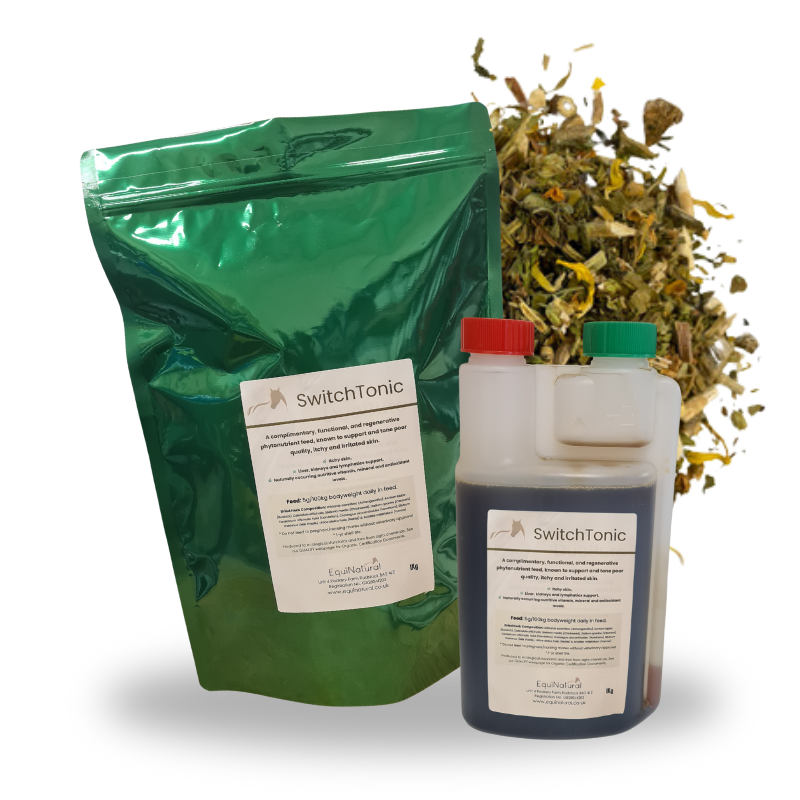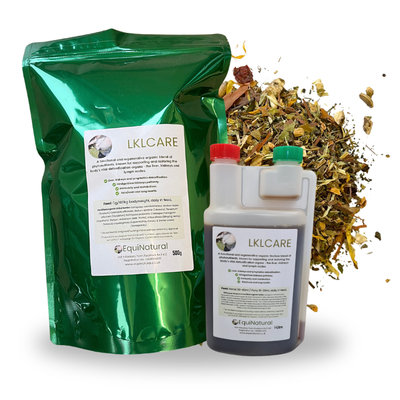ESTABLISHED 2006
Over 50,000 Orders Shipped
NEXT DAY UK DELIVERY
Worldwide Shipping 3-5 Days
SUBSCRIPTIONS
Subscribe & Save!
RATED ★ ★ ★ ★ ★
1100+ 5* Reviews
SWITCHTONIC *Supports itchy, irritated skin/coat
SwItchTonic is a carefully crafted blend of functional and regenerative organic phytonutrients, specially formulated to help manage itchy, irritated skin.
With its potent antipruritic (anti-itch) properties, SwItchTonic works to support skin and coat health while addressing the deeper systemic imbalances often associated with sweet itch.
Customer Approved
✨ “The best my horse’s sweet itch has been - thank you."
✨ “I’m delighted! The itching stopped within days.”
Why choose SwItchTonic?
Sweet itch and persistent skin irritations are more than just surface problems - they’re often rooted in systemic imbalances.
SwItchTonic goes beyond soothing symptoms to address underlying causes by supporting gut health, liver and kidney function, and the natural detoxification pathways essential for maintaining a healthy skin biome.
~ Soothes itchy, irritated skin
Targeted formula for itchy, inflamed skin conditions.
~ Supports the detoxification organs
Helps enhance liver, kidney, and lymphatic system function.
~ Nutrient-rich
Packed with naturally occurring vitamins, minerals, and antioxidants to nourish from within.
Overview
As the saying goes, "Beauty comes from within," and the skin is a direct reflection of what’s happening beneath the surface. When it comes to itchy skin, the root cause often starts with the gut.
Sweet itch - more than a kkin problem
Sweet itch, one of the worst equine skin torments, has been a personal battle for two of Carol's (EquiNatural's founder) horses, Kelso and Mac. While it was traditionally thought to be an autoimmune response to the Culicoides midge, recent research (2021) reveals that sweet itch is not merely a skin issue. The skin symptoms are undeniable, but the underlying cause lies in the gut, where a significantly disturbed microbiome leads to extensive inflammation of the gut lining.
This inflammation triggers a hyperactive immune response, leaving the body highly sensitive to allergens and resulting in a massive increase in toxins. In essence, sweet itch is an autoimmune issue.
The role of the kidneys and skin
The kidneys, tasked with excreting toxins while maintaining vital balances (acid-base, minerals, water, and blood pressure), have a limited capacity. When overwhelmed, the y rely on an emergency detox pathway—the skin. This overload leads to excessive toxin excretion through the skin, causing severe itching, particularly in summer when insect bites compound the problem.
Fly rugs can help by preventing midge bites, reducing symptoms. However, for some horses, the metabolic burden is so overwhelming that the skin becomes the primary elimination organ. This explains why some horses scratch persistently, even in winter.
The hidden danger of kidney overload
A major challenge is that kidney insufficiency often remains invisible until significant damage - up to 70% - has occurred. This makes early intervention critical. For sweet itch or fly-affected horses, fly rugs provide some relief, but for horses with non-sweet itch-related skin issues, the root cause is often severe gut biome dysbiosis.
A whole-body approach
To truly address itchy skin, we need to consider the entire detoxification system: the gut, liver, and kidneys. If the kidneys are overloaded, the liver is likely struggling too, disrupting the toxin biotransformation process. This creates a chain reaction that begins with gut biome imbalance and ends with the skin serving as an emergency excretion pathway.
This same process applies to conditions like mallenders and sallenders, which are also linked to impaired liver and kidney function.
What to do next
1. Stabilise the skin biome
Avoid harmful, chemical-laden shampoos that strip the skin of its natural oils.
2. Fortify the diet
Replace ultra-processed feeds with clean, grass-forage-based feeds (e.g., grass nuts, cobs, or chaff). Keep sugar and acid content low. If your horse has been fed haylage, feed spirulina for one month to bind intestinal toxins, deacidify the hindgut, and support gut health. Provide ad-lib stemmy hay to ensure plenty of cellulose fibre is passing through the colon, helping recolonize beneficial hindgut microbes.
3. Linseed
Additionally, linseed has been shown to help control itchy skin caused by Culicoides midge bites (Canadian Journal of Veterinary Research, October 2002).
New research
As of October 2021, emerging research suggests that sweet itch is connected to a widespread, multi-metabolic detoxification disorder called Cryptopyrroluria(KPU). For more information, visit our KPU page
.
Important Note
SwItchTonic is a nutritional, functional food supplement and not veterinary medicine. For more information, refer to Dr Kellon's article - Nutrition is not 'Alternative' Therapy
.
For the latest research and updates, see our main
A-Z Coat & Skin
page.
Composition & Feed Guide
Dried Herbs
Human grade, produced to ecological standards and free from agro-chemicals. See our Quality page for Organic Certification Documents.
- Feed 5g/100kg bodyweight per day, i.e. 25g for a 500kg horse.
Tincture
Our human-grade, certified organic tinctures provide a ready-to-absorb potent source of phytonutrients, for immediate absorption into the bloodstream.- Feed 6ml/100kg bodyweight per day, i.e. 30ml for a 500kg horse. Shake well before use.
Composition
Withania somnifera, Arctium lappa, Calendula officinalis, Stellaria media, Taraxicum officinalis Folia, Crataegus oxycanthoides, Silybum marianum, Urtical dioica Folia, & Achillea millefolium*
* Grown especially for us organically and biodynamically by Organic Herb Trading Co. https://www.biodynamics.com/what-is-biodynamics
* Supplements of any kind should be fed with caution to the pregnant or nursing mare so always seek veterinary advice.
Recommended
Start feeding 4 weeks before the spring midge season and continue until end-autumn.
The EquiNatural Blog

Menu
Get in Touch
+44 01761 325032
mail@equinatural.co.uk
Unit 4 Rookery Farm, Radstock, BA3 4UL
Terms & Conditions
Privacy Policy
Legal Notice
Stay Connected
Subscribe to our emails for the latest insights, updates, tips, and offers.
Contact us
Thank You for Joining Us!
We’re so pleased to welcome you to the EquiNatural community. Keep an eye on your inbox for updates, tips, and exclusive offers to help your horse thrive naturally.
Warm wishes
The EquiNatural Team
Please try again later
Any information contained within is not intended to replace veterinary or other professional advice.
*
Trading Standards EC Feed Hygiene Regulation (183/2005), Registration No. GB280/4203
* HACCP certified facility (an international standard that ensures we meet food safety standards)
* Registered in England. Company Number 11075894 - Reg'd Office: Unit 10 Rookery Farm, Radstock BA3 4UL
* VAT No. GB 310214964





